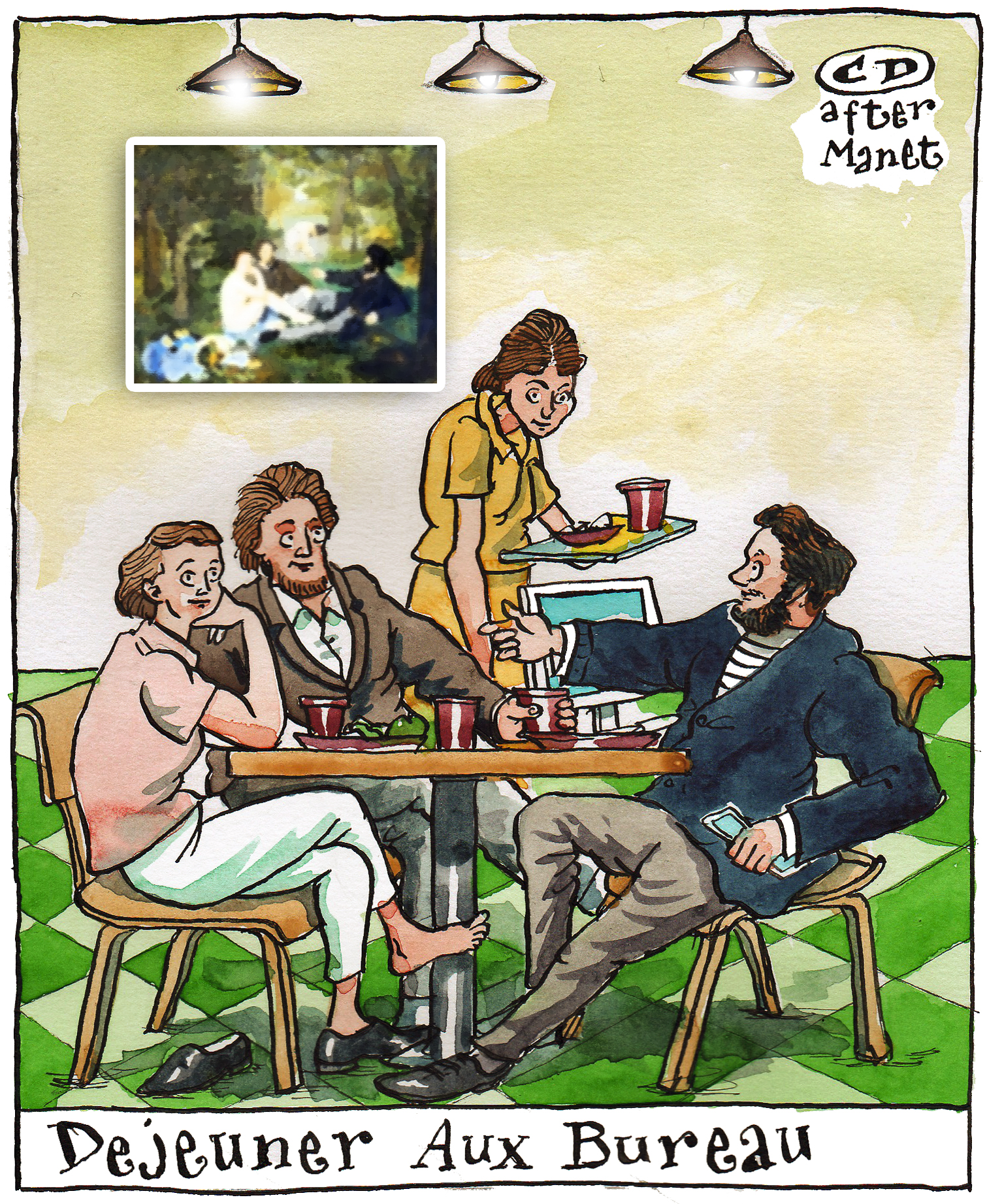The company that eats together stays together
I was in the City one evening last week, going past the London headquarters of Bank of America. I noticed that a steady stream of Just Eat, Uber Eats and Deliveroo cyclists were arriving and being kettled by a security guard in a covered area outside, near the main door. This was 7.15pm and in the space of less than ten minutes about fifteen different cyclists arrived following signs to “new food delivery point”, a roped-off area. All the while, bankers were coming out of the revolving doors and receiving their food from beyond the rope, as if they were Tour de France riders grabbing their musettes before going back upstairs.
Of course, there is a reason for this phenomenon. Banks, large accountancy firms and City lawyers now often sign up as corporate customers to food delivery companies. Instead of offering staff a good-quality canteen, they give them a daily £30 Deliveroo or Uber Eats allowance.
I found the scene rather depressing: bankers working late and munching on Dishoom curries and over-priced Korean chicken wings at their desks. There is a generation of workers who not only do not really like working but also, for very understandable reasons, resent coming into the office when they can do the job just as well from home. Is handing them a generous takeaway voucher really the answer? Isn’t this just reinforcing the atomisation of office life?

There is an alternative. Eat together as a company. This is an idea favoured by Eccie Newton, who has co-founded a couple of companies that between them employ about 70 people. “Every day we stop and eat together,” she says. “Literally. A bell goes off at midday and we down tools. We all sit down together and we can talk about things, not necessarily work, but we’re talking about ideas and how we feel.”
This, to me, sounds as much fun as sawing off my left arm with a blunt bread knife. When I worked in an office, lunchtime was an opportunity to escape, to get some fresh air, not share a pilaf with my boss. If it was raining, I would hide myself in the furthest corner of the newspaper’s office, often on a spare desk behind the obituaries department, with the crossword and my homemade sarnie to avoid having to make polite chit chat with any of my superiors.
But Newton is not only charming, displaying none of the sociopathic tendencies that some of my former colleagues harboured, but also is quite persuasive about the benefits of communal eating. For starters, her main company, Karma Cans, is an office food delivery company. She supplies the London offices of Meta, Microsoft and Amazon with catering for meetings and these technology offices’ group lunches. So it is in her interest to promote the idea of office lunches. The food her company eats at midday is the same menu it has sent out to other companies around the capital. Having a high-quality kitchen on site helps, so does having a workforce whose mission is food, but her point is that it has a benefit beyond the touchy-feely sense of community. “Having a moment in the day when you can form connections with somebody in a different team leads to better-quality communications across the company.”
There was an era when many workplaces had strictly hierarchical eating arrangements. The Raleigh bicycle factory had fifteen different staff canteens, one for each rank of worker, from directors down to the most basic shopfloor workers. Newton believes her company lunch, which she insists is voluntary, breaks up these segregations.
There is some science to back this up. Commensality is the lovely, technical word for eating together and Robin Dunbar, an Oxford professor of evolutionary psychology, has suggested that eating together drives social connections rather than the other way around. It holds true for workplaces, too, according to some studies. Cornell University undertook an analysis of firehouses in America and found that firemen who ate together at work were more productive and displayed greater cohesion. Nesta, a British research and innovation group, ran a small-scale experiment encouraging workers to eat together at the same table once a week. The benefits of commensality were felt beyond the weekly activity and solo desk eaters on other days of the week fell from 37 per cent to 25 per cent.
Although Karma Cans’ formal bell-ringing is highly unusual, quite a few organisations try to eat together occasionally. Nebel Crowhurst is chief people officer at Reward Gateway, an employee benefits platform. Its own office has a large stand-up table where workers gather to eat and snack. Although it is not as civilised as sitting down for a chef-cooked meal, it is a chance to chat to people from other departments. “It makes a difference in wanting to show up to the office, in wanting to feel connected,” she says. “People want to feel part of something, which we lost for a few years because of the pandemic.”
My lunchtime misanthropy was rooted in an era when we had to turn up to the office religiously, five days a week. Lunchtime was a sliver of freedom, either for running errands or for tracking down a Pret without a queue. However, now that many office drones spend at least a day a week working from home, the necessity to carve out time for a haircut or a visit to the phone repair shop is less pressing.
For most companies, certainly those with more than 100 employees, sitting down together is not practical, but for the office to have meaning to a generation that started working life during or after Covid it needs to offer something beyond superficial face-to-face interactions and a few tax-deductible perks. Maybe the occasional shared meal, if not daily, is preferable to everyone swiping on the Deliveroo app for another meal to end up as crumbs on your keyboard.
Harry Wallop is a consumer journalist and broadcaster. Follow him on Twitter/X @hwallop




Post Comment